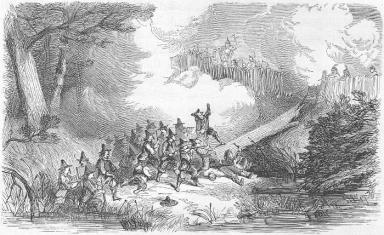Source Text:
The first major war between the colonists and the Indians was the result of a lack of policy governing the officiating of disputes between the two groups. From the time that the Europeans found their way to the New World and discovered the “savages,” as the native people were labeled, it became their mission to impart the saving grace of Christianity on the unlearned. One such minister was the Englishman John Eliot. The missionary effort was successful in creating what became known as “praying Indians,” and led to some Indians learning English very well; becoming translators for trade and land deals and some even obtained a college education. This also created a rift between the two groups with the converts being stuck in the middle.
The troubles in New England began when the Indian tribes began to have younger and younger members who were outraged at the settlers trespassing on their land, spreading diseases and religious beliefs and depleting the natural resources. When chief Metacomet (named King Philip by the British when he was younger and ironically, the son of the chief who had helped the Plymouth Colony establish itself in the area) became the leader of Wampanoag tribe, he began to make plots to run the New Englanders off of his land. One of the Christian convert Indians, John Sassamon, tried to stop the violence before it started by informing the colonists of what was happening. A few days after he had leaked the plot, he was found dead in a nearby pond, allegedly as revenge for betraying his native people. The English decided that it was their responsibility to hold a trial to prosecute those who had murdered the young brave and eventually hanged three Indian suspects. The powder keg had been lit and over the next few months the Indians raided and pillaged in a battle that lasted to the death.
From this point until the end it was either the Indians or the colonists who would survive and therefore control all of the land, there would be no more sharing. The Indians were well equipped with English firearms acquired through trading and fought bravely. The Indians attacked small villages and instilled fear in the colonists with their hit and run tactics. Many villages and farms were burned to the ground on both sides as the colonists roused as many militiamen as they could for all-out attacks on the Indian tribes. In the end it was a lack of unity that undid the war for the natives. The Mohawk Indians were quite happy with the spoils of trading with the British and elected not to get involved in the fighting. Without the extra support, the colonists slowly decimated the Indians and scattered the few survivors to live as refugees in neighboring tribes, while many of the converted Indians mutinied and sided with the colonists. The victory wasn’t without its costs. Over a dozen colonial towns were completely destroyed, over 1,000 colonists were dead (about ⅓ of the Indian casualties) and ruined farms and houses dotted the countryside. The whole of New England was thrown into a debt of over £15,000 which was more than the value of the entire colony making King Philip’s War the costliest war (per capita) in American history. When Metacomet was finally killed in 1676, he was drawn and quartered and his head was paraded into the city of Plymouth where it remained on display for over 25 years while his son was sold into slavery in the Caribbean.
Source Facts:
event, location
Source Info:
Article on King Phillip's War
Created By: ellie @ 04/15/16 06:27:37PM
Last Updated: 07/15/18 12:41:58PM
Source URL: http://www.sussexvt.k12.de.us/science/The%20History%20of%20the%20World%201500-1899/King%20Philip.htm
